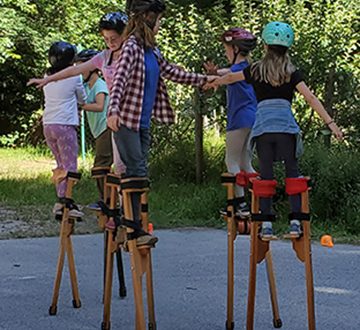
Take a Breath
BY LAURA MAXSON, LM
 Rising levels of the hormone progesterone cause respiration rates to increase, surprising some women with shortness of breath even at the very early stages of pregnancy. As pregnancy progresses, the uterus invades the usual breathing space, putting pressure on the diaphragm. The rib cage widens in response, to give the lungs more volume. There can be some real discomfort as the rib cage moves and stretches, especially when there is a little foot up there helping out.
Rising levels of the hormone progesterone cause respiration rates to increase, surprising some women with shortness of breath even at the very early stages of pregnancy. As pregnancy progresses, the uterus invades the usual breathing space, putting pressure on the diaphragm. The rib cage widens in response, to give the lungs more volume. There can be some real discomfort as the rib cage moves and stretches, especially when there is a little foot up there helping out.
Other changes in the pregnant body help the breathing process be more effective. From dilated bronchi to more efficient chemical exchanges in the alveoli of the lungs, the pregnant woman breathes more efficiently.
Although a woman might feel short of breath at times, the amount of air that is moved with breathing is actually increased in pregnancy. Sometimes this can cause a person to suddenly feel more conscious of breathing, leading to anxious feelings. Simply changing positions can help. Move to sitting or standing, open a window and get some fresh air. Lifting the arms overhead can also help lift the diaphragm and open the chest to give the feeling of a little more room.
Another cause for feeling short of breath is the normal hemodilution that takes place around 28 to 32 weeks as the body increases its blood supply. Plasma quickly increases, but red blood cells take weeks to grow. This results in a few weeks of proportionally fewer oxygen-carrying red blood cells in the blood supply mimicking symptoms of anemia.
Of course, shortness of breath can also be a sign of true anemia caused by low iron levels. Anytime there is pronounced shortness of breath or chest pain, a care provider should be seen immediately to rule out rare but serious issues.
The same hormones of pregnancy that are busy helping grow a baby can cause an increased vascularity and general swelling of the tissues in the nasal passages. The chronic stuffy nose that results can be annoying and cause snoring and restless sleep. Nosebleeds are common, too. A humidifier can be a helpful addition for sleep and can be useful after birth to ease stuffy noses for babies, as well.
Breathing is a big part of most labor coping techniques. Breath control and conscious breathing are a focus of almost all childbirth preparation. Some breathing methods are more involved than others, but most aim for a slow relaxing breath. Long, slow exhalations, often accompanied by a toning/ohming sound, can make contractions much more manageable. A deep cleansing breath at the end of each contraction can help release any leftover tension in the body and signal others that the contraction is over.
At times, breathing patterns can become too fast, resulting in hyperventilation: causing tingling of the face and feeling faint. Temporarily decreasing oxygen intake by re-breathing exhaled air will take care of this problem. If the classic paper bag isn’t available, breathing into cupped hands placed around the nose and mouth, for several breaths usually works. Many women find that focusing on breathing is their number one coping mechanism for labor.
A powerful tool for those working with laboring women is the use of directed breathing to pull someone back from panic or an out-of-control moment in labor. Simply get up close – face-to-face, eye-to-eye, and model slow deep breaths. Soon they are breathing more slowly, the contraction is ending and everyone can regroup for the next contraction. When it comes time to push – soft, spontaneous grunts or bellowing roars – breath is important. Often quick and shallow pants can help ease out a crowning head.
When a woman gets up for the first time after birth, she may suddenly become aware of her breath once again, as her lungs and diaphragm that have felt the firm pressure of a pregnant uterus for months are suddenly left unsupported. This change can leave a woman feeling as though she can’t breathe properly, when in fact she is breathing just fine. Being prepared for it can help lessen the odd feeling.
That slow, deep labor breathing technique can also work wonders when coping with sore nipples, colic, teething, tantrums and teenagers. Breathing is powerful – keep it up!


You May Also Like

Family Folk Music Camp in Your Own Backyard
March 1, 2020
This School is a Real Circus
March 1, 2020

